air condition RENAULT TWINGO 2009 2.G Electrical Equipment - Radio R2-08 Workshop Manual
[x] Cancel search | Manufacturer: RENAULT, Model Year: 2009, Model line: TWINGO, Model: RENAULT TWINGO 2009 2.GPages: 106, PDF Size: 0.61 MB
Page 4 of 106

86A-4V1 MR-413-X44-86A150$010.mif
RADIO
Fault finding – Introduction86A
R2-08
Vdiag No.: 64
Conformity check
The purpose of the conformity check is to check data that does not produce a fault on the diagnostic tool when the
data is inconsistent. Therefore, this stage is used to:
–carry out fault finding on faults that do not have a fault display, and which may correspond to a customer complaint.
–check that the system is operating correctly and that there is no risk of a fault recurring after repair.
This section gives the fault finding procedures for statuses and parameters and the conditions for checking them.
If a status is not behaving normally or a parameter is outside permitted tolerance values, you should consult the
corresponding fault finding page.
Customer complaints - Fault finding chart
If the test with the diagnostic tool is OK but the customer complaint is still present, the fault should be dealt with by
customer complaints.
A synopsis of the general procedure to follow is provided on the following page in the form of a flow chart.
Page 5 of 106
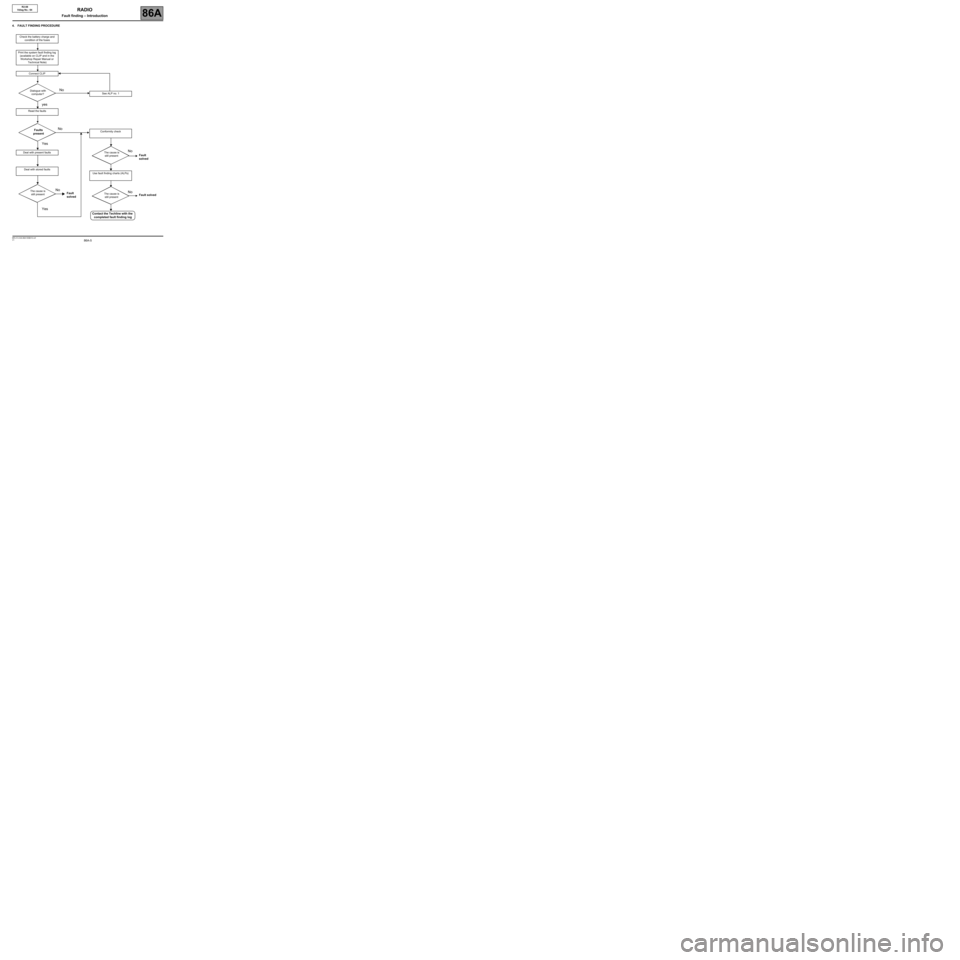
86A-5V1 MR-413-X44-86A150$010.mif
RADIO
Fault finding – Introduction86A
R2-08
Vdiag No.: 64
4. FAULT FINDING PROCEDURE
Check the battery charge and
condition of the fuses
Print the system fault finding log
(available on CLIP and in the
Workshop Repair Manual or
Technical Note)
Connect CLIP
See ALP no. 1
Read the faults
Deal with present faults
Deal with stored faults
Conformity check
Use fault finding charts (ALPs)
Dialogue with
computer?
Faults
present
The cause is
still present
The cause is
still presentThe cause is
still present
Contact the Techline with the
completed fault finding log
No
NoNo
No No
yes
Yes
Yes
Fault
solvedFault solved Fault
solved
Page 8 of 106

86A-8V1 MR-413-X44-86A150$010.mif
RADIO
Fault finding – Introduction86A
R2-08
Vdiag No.: 64
1. Visual inspection of the connection:
–Check that the connector is connected correctly and that the male and female parts of the connection are
correctly coupled.
2. Visual inspection of the area around the connection:
–Check the condition of the mounting (pin, strap, adhesive tape, etc.) if the connectors are attached to the vehicle.
–Check that there is no damage to the wiring trim (sheath, foam, adhesive tape, etc.) near the wiring.
–Check that there is no damage to the electrical wires at the connector outputs, in particular on the insulating
material (wear, cuts, burns, etc.).
Disconnect the connector to continue the checks.
3. Visual inspection of the plastic casing:
–Check that there is no mechanical damage (casing crushed, cracked, broken, etc.), in particular to the fragile
components (lever, lock, openings, etc.).
–Check that there is no heat damage (casing melted, darker, deformed, etc.).
–Check that there are no stains (grease, mud, liquid, etc.).
4. Visual inspection of the metal contacts:
(The female contact is called CLIP. The male contact is called TAB).
–Check that there are no bent contacts (the contact is not inserted correctly and can come out of the back of the
connector). The contact comes out of the connector when the wire is gently pulled.
–Check that there is no damage (folded tabs, clips open too wide, blackened or melted contact, etc.).
–Check that there is no oxidation on the metal contacts.
5. Visual inspection of the sealing:
(Only for watertight connectors)
Check for the seal on the connection (between the 2 parts of the connection).
–Check the seal at the back of the connectors:
–For unit joints (1 for each wire), check that the unit joints are present on each electrical wire and that they are
correctly positioned in the opening (level with the housing). Check that plugs are present on openings which
are not used.
–For a grommet seal (one seal which covers the entire internal surface of the connector), check that the seal
is present.
–For gel seals, check for gel in all of the openings without removing the excess or any protruding sections
(it does not matter if there is gel on the contacts).
–For hotmelt sealing (heat-shrink sheath with glue), check that the sheath has contracted correctly on the rear
of the connectors and electrical wires, and that the hardened glue comes out of the side of the wire.
–Check that there is no damage to any of the seals (cuts, burns, significant deformation, etc.).
If a fault is detected, consult Technical Note 6015A, Repairing electrical wiring.
Page 33 of 106
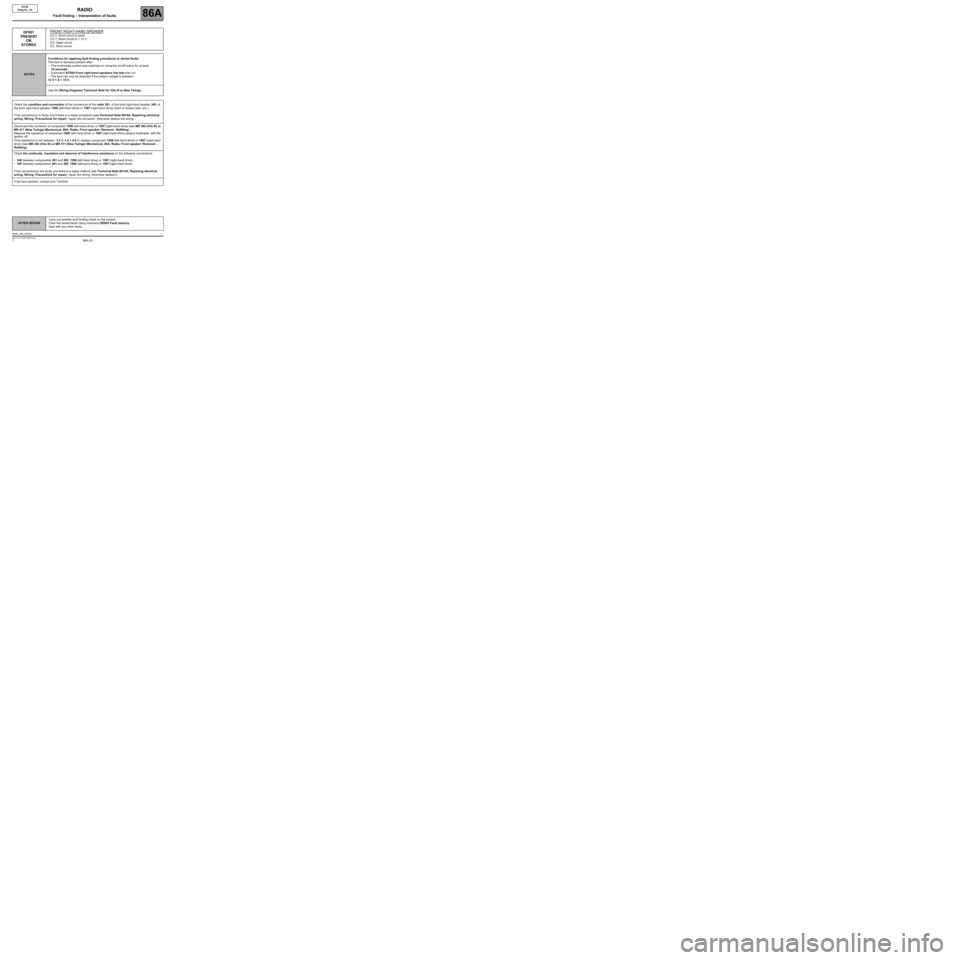
86A-33
AFTER REPAIRCarry out another fault finding check on the system.
Clear the stored faults using command RZ003 Fault memory.
Deal with any other faults.
V1 MR-413-X44-86A150$120.mif
86A
R2-08
Vdiag No.: 64
DF001
PRESENT
OR
STOREDFRONT RIGHT-HAND SPEAKERCC.0: Short circuit to earth
CC.1: Short circuit to + 12 V
CO: Open circuit
CC: Short circuit
NOTESConditions for applying fault finding procedures to stored faults:
The fault is declared present after:
–The multimedia system was switched on using the on/off button for at least
10 seconds,
–Command AC004 Front right-hand speakers line test was run.
–The fault can only be detected if the battery voltage is between:
12 V < X < 15 V.
Use the Wiring Diagrams Technical Note for Clio III or New Twingo.
Check the condition and connection of the connectors of the radio 261, of the front right-hand tweeter 365, of
the front right-hand speaker 1598 (left-hand drive) or 1597 (right-hand drive) (bent or broken tabs, etc.).
If the connector(s) is faulty and if there is a repair procedure (see Technical Note 6015A, Repairing electrical
wiring, Wiring: Precautions for repair), repair the connector, otherwise replace the wiring.
Disconnect the connector of component 1598 (left-hand drive) or 1597 (right-hand drive) (see MR 392 (Clio III) or
MR 411 (New Twingo) Mechanical, 86A, Radio, Front speaker: Removal - Refitting).
Measure the resistance of component 1598 (left-hand drive) or 1597 (right-hand drive) using a multimeter, with the
ignition off.
If the resistance is not between: 3.5 Ω < X < 4.5 Ω, replace component 1598 (left-hand drive) or 1597 (right-hand
drive) (see MR 392 (Clio III) or MR 411 (New Twingo) Mechanical, 86A, Radio, Front speaker: Removal -
Refitting).
Check the continuity, insulation and absence of interference resistance on the following connections:
•34E between components 261 and 365, 1598 (left-hand drive) or 1597 (right-hand drive),
•34F between components 261 and 365, 1598 (left-hand drive) or 1597 (right-hand drive).
If the connection(s) are faulty and there is a repair method (see Technical Note 6015A, Repairing electrical
wiring, Wiring: Precautions for repair), repair the wiring, otherwise replace it.
If the fault persists, contact your Techline.
R208_V64_DF001
RADIO
Fault finding – Interpretation of faults
Page 34 of 106
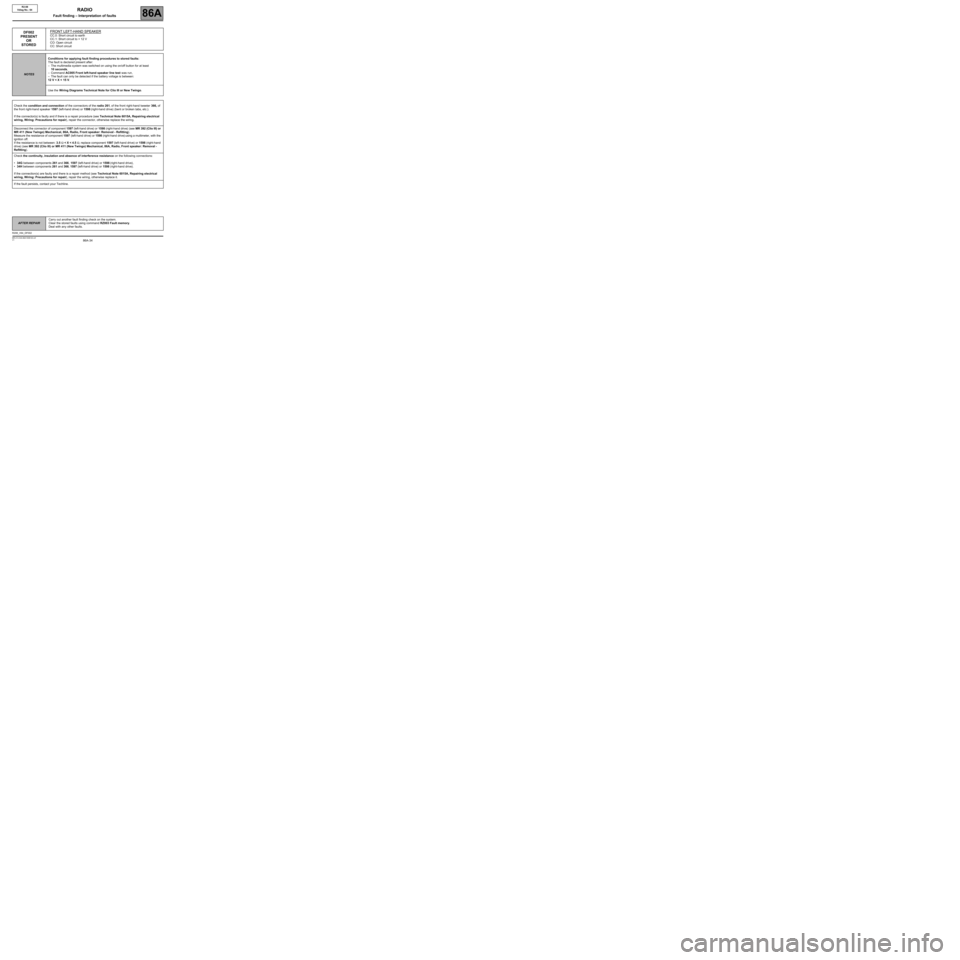
86A-34
AFTER REPAIRCarry out another fault finding check on the system.
Clear the stored faults using command RZ003 Fault memory.
Deal with any other faults.
V1 MR-413-X44-86A150$120.mif
RADIO
Fault finding – Interpretation of faults86A
R2-08
Vdiag No.: 64
DF002
PRESENT
OR
STOREDFRONT LEFT-HAND SPEAKERCC.0: Short circuit to earth
CC.1: Short circuit to + 12 V
CO: Open circuit
CC: Short circuit
NOTESConditions for applying fault finding procedures to stored faults:
The fault is declared present after:
–The multimedia system was switched on using the on/off button for at least
10 seconds,
–Command AC005 Front left-hand speaker line test was run,
–The fault can only be detected if the battery voltage is between:
12 V < X < 15 V.
Use the Wiring Diagrams Technical Note for Clio III or New Twingo.
Check the condition and connection of the connectors of the radio 261, of the front right-hand tweeter 366, of
the front right-hand speaker 1597 (left-hand drive) or 1598 (right-hand drive) (bent or broken tabs, etc.).
If the connector(s) is faulty and if there is a repair procedure (see Technical Note 6015A, Repairing electrical
wiring, Wiring: Precautions for repair), repair the connector, otherwise replace the wiring.
Disconnect the connector of component 1597 (left-hand drive) or 1598 (right-hand drive) (see MR 392 (Clio III) or
MR 411 (New Twingo) Mechanical, 86A, Radio, Front speaker: Removal - Refitting).
Measure the resistance of component 1597 (left-hand drive) or 1598 (right-hand drive) using a multimeter, with the
ignition off.
If the resistance is not between: 3.5 Ω < X < 4.5 Ω, replace component 1597 (left-hand drive) or 1598 (right-hand
drive) (see MR 392 (Clio III) or MR 411 (New Twingo) Mechanical, 86A, Radio, Front speaker: Removal -
Refitting).
Check the continuity, insulation and absence of interference resistance on the following connections:
•34G between components 261 and 366, 1597 (left-hand drive) or 1598 (right-hand drive),
•34H between components 261 and 366, 1597 (left-hand drive) or 1598 (right-hand drive).
If the connection(s) are faulty and there is a repair method (see Technical Note 6015A, Repairing electrical
wiring, Wiring: Precautions for repair), repair the wiring, otherwise replace it.
If the fault persists, contact your Techline.
R208_V64_DF002
Page 35 of 106
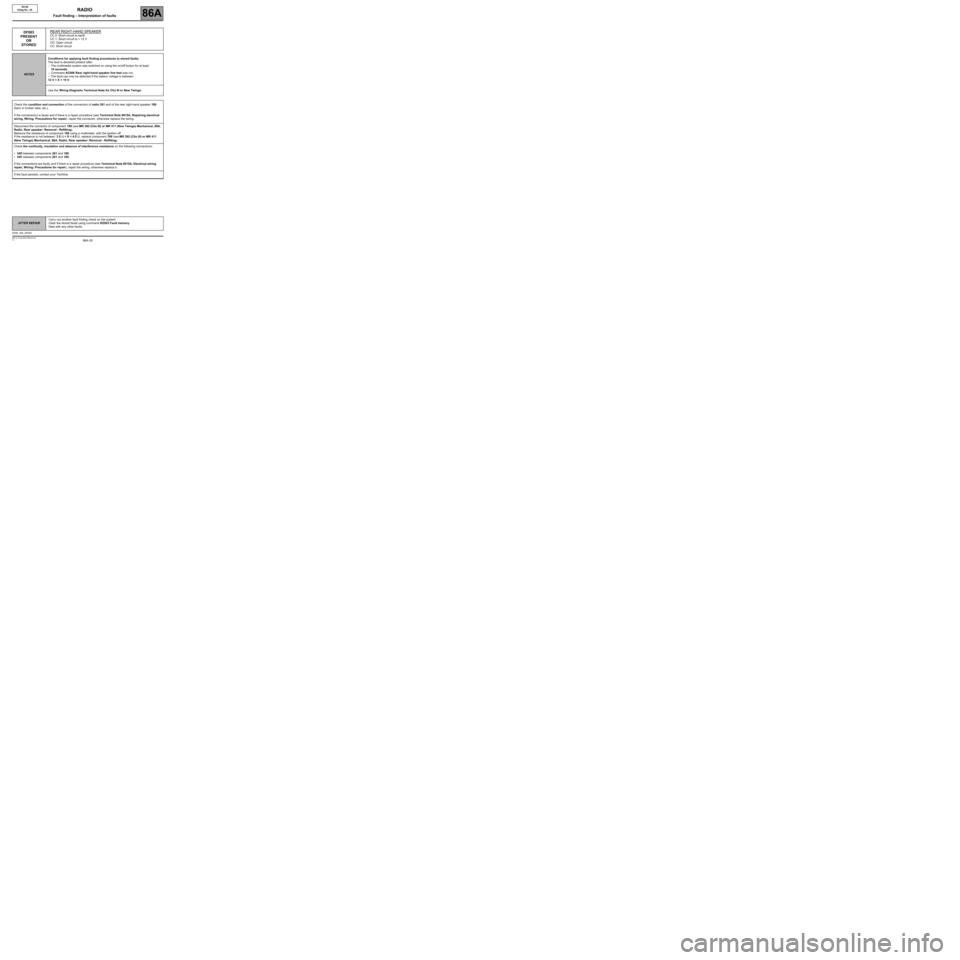
86A-35
AFTER REPAIRCarry out another fault finding check on the system.
Clear the stored faults using command RZ003 Fault memory.
Deal with any other faults.
V1 MR-413-X44-86A150$120.mif
RADIO
Fault finding – Interpretation of faults86A
R2-08
Vdiag No.: 64
DF003
PRESENT
OR
STOREDREAR RIGHT-HAND SPEAKERCC.0: Short circuit to earth
CC.1: Short circuit to + 12 V
CO: Open circuit
CC: Short circuit
NOTESConditions for applying fault finding procedures to stored faults:
The fault is declared present after:
–The multimedia system was switched on using the on/off button for at least
10 seconds,
–Command AC006 Rear right-hand speaker line test was run,
–The fault can only be detected if the battery voltage is between:
12 V < X < 15 V.
Use the Wiring Diagrams Technical Note for Clio III or New Twingo.
Check the condition and connection of the connectors of radio 261 and of the rear right-hand speaker 189
(bent or broken tabs, etc.).
If the connector(s) is faulty and if there is a repair procedure (see Technical Note 6015A, Repairing electrical
wiring, Wiring: Precautions for repair), repair the connector, otherwise replace the wiring.
Disconnect the connector of component 189 (see MR 392 (Clio III) or MR 411 (New Twingo) Mechanical, 86A,
Radio, Rear speaker: Removal - Refitting).
Measure the resistance of component 189 using a multimeter, with the ignition off.
If the resistance is not between: 3.5 Ω < X < 4.5 Ω, replace component 189 (see MR 392 (Clio III) or MR 411
(New Twingo) Mechanical, 86A, Radio, Rear speaker: Removal - Refitting).
Check the continuity, insulation and absence of interference resistance on the following connections:
•34D between components 261 and 189,
•34C between components 261 and 189.
If the connections are faulty and if there is a repair procedure (see Technical Note 6015A, Electrical wiring
repair, Wiring: Precautions for repair), repair the wiring, otherwise replace it.
If the fault persists, contact your Techline.
R208_V64_DF003
Page 36 of 106
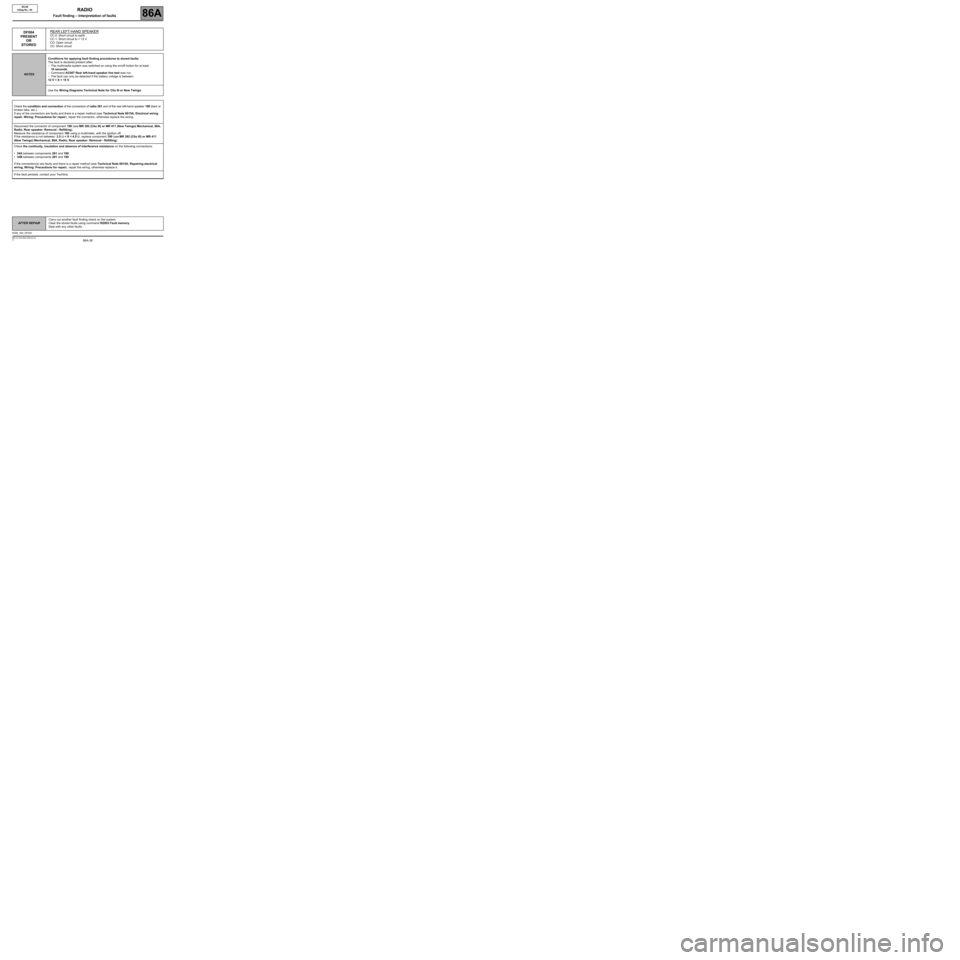
86A-36
AFTER REPAIRCarry out another fault finding check on the system.
Clear the stored faults using command RZ003 Fault memory.
Deal with any other faults.
V1 MR-413-X44-86A150$120.mif
RADIO
Fault finding – Interpretation of faults86A
R2-08
Vdiag No.: 64
DF004
PRESENT
OR
STOREDREAR LEFT-HAND SPEAKERCC.0: Short circuit to earth
CC.1: Short circuit to + 12 V
CO: Open circuit
CC: Short circuit
NOTESConditions for applying fault finding procedures to stored faults:
The fault is declared present after:
–The multimedia system was switched on using the on/off button for at least
10 seconds,
–Command AC007 Rear left-hand speaker line test was run,
–The fault can only be detected if the battery voltage is between:
12 V < X < 15 V.
Use the Wiring Diagrams Technical Note for Clio III or New Twingo.
Check the condition and connection of the connectors of radio 261 and of the rear left-hand speaker 190 (bent or
broken tabs, etc.).
If any of the connectors are faulty and there is a repair method (see Technical Note 6015A, Electrical wiring
repair, Wiring: Precautions for repair), repair the connector, otherwise replace the wiring.
Disconnect the connector of component 190 (see MR 392 (Clio III) or MR 411 (New Twingo) Mechanical, 86A,
Radio, Rear speaker: Removal - Refitting).
Measure the resistance of component 190 using a multimeter, with the ignition off.
If the resistance is not between: 3.5 Ω < X < 4.5 Ω, replace component 190 (see MR 392 (Clio III) or MR 411
(New Twingo) Mechanical, 86A, Radio, Rear speaker: Removal - Refitting).
Check the continuity, insulation and absence of interference resistance on the following connections:
•34A between components 261 and 190,
•34B between components 261 and 190.
If the connection(s) are faulty and there is a repair method (see Technical Note 6015A, Repairing electrical
wiring, Wiring: Precautions for repair), repair the wiring, otherwise replace it.
If the fault persists, contact your Techline.
R208_V64_DF004
Page 37 of 106
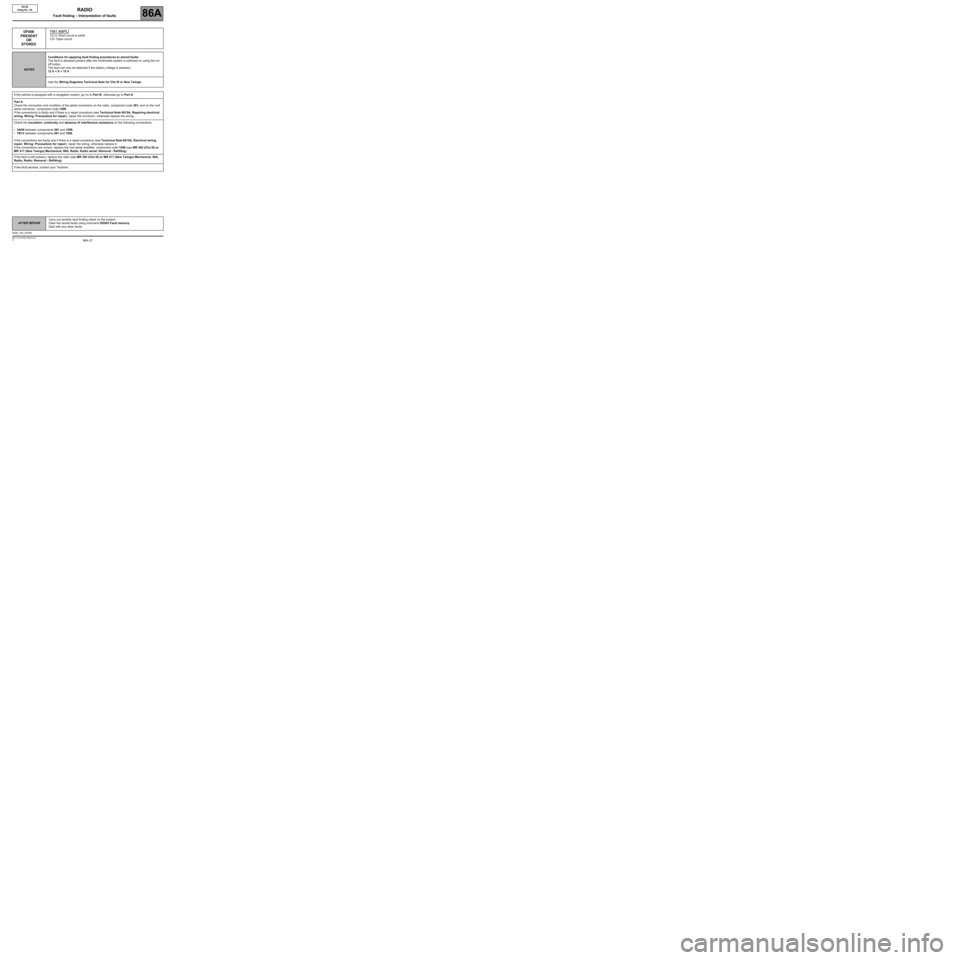
86A-37
AFTER REPAIRCarry out another fault finding check on the system.
Clear the stored faults using command RZ003 Fault memory.
Deal with any other faults.
V1 MR-413-X44-86A150$120.mif
RADIO
Fault finding – Interpretation of faults86A
R2-08
Vdiag No.: 64
DF006
PRESENT
OR
STOREDFM1 AMPLI
CC.0: Short circuit to earth
CO: Open circuit
NOTESConditions for applying fault finding procedures to stored faults:
The fault is declared present after the multimedia system is switched on using the on/
off button.
The fault can only be detected if the battery voltage is between:
12 V < X < 15 V.
Use the Wiring Diagrams Technical Note for Clio III or New Twingo.
If the vehicle is equipped with a navigation system, go on to Part B, otherwise go to Part A.
Part A:
Check the connection and condition of the aerial connectors on the radio, component code 261, and on the roof
aerial connector, component code 1208.
If the connector(s) is faulty and if there is a repair procedure (see Technical Note 6015A, Repairing electrical
wiring, Wiring: Precautions for repair), repair the connector, otherwise replace the wiring.
Check the insulation, continuity and absence of interference resistance on the following connections:
•34AN between components 261 and 1208,
•TB13 between components 261 and 1208.
If the connections are faulty and if there is a repair procedure (see Technical Note 6015A, Electrical wiring
repair, Wiring: Precautions for repair), repair the wiring, otherwise replace it.
If the connections are correct, replace the roof aerial amplifier, component code 1208 (see MR 392 (Clio III) or
MR 411 (New Twingo) Mechanical, 86A, Radio, Radio aerial: Removal - Refitting).
If the fault is still present, replace the radio (see MR 392 (Clio III) or MR 411 (New Twingo) Mechanical, 86A,
Radio, Radio: Removal - Refitting).
If the fault persists, contact your Techline.
R208_V64_DF006
Page 38 of 106

86A-38
AFTER REPAIRCarry out another fault finding check on the system.
Clear the stored faults using command RZ003 Fault memory.
Deal with any other faults.
V1 MR-413-X44-86A150$120.mif
RADIO
Fault finding – Interpretation of faults86A
R2-08
Vdiag No.: 64
DF006
CONTINUED
Part B:
Check the connection and condition of the aerial connectors on the radio and navigation system, component codes
261 and 662, and of the connector on the roof aerial, component code 1874.
If the connector(s) is faulty and if there is a repair procedure (see Technical Note 6015A, Repairing electrical
wiring, Wiring: Precautions for repair), repair the connector, otherwise replace the wiring.
Check the insulation, continuity and absence of interference resistance on the following connections:
•46CJ between components 261 and 662,
•TB82 between components 261 and 662.
If the connection(s) are faulty and there is a repair method (see Technical Note 6015A, Repairing electrical
wiring, Wiring: Precautions for repair), repair the wiring, otherwise replace it.
Check the insulation, continuity and absence of interference resistance on the following connections:
•34EP between components 261 and 1874,
•TB39 between components 261 and 1874.
If the connection(s) are faulty and there is a repair method (see Technical Note 6015A, Repairing electrical
wiring, Wiring: Precautions for repair), repair the wiring, otherwise replace it.
If the connections are correct, replace the roof aerial amplifier, component code 1874 (see MR 392, Mechanical,
86A, Radio, Radio aerial: Removal - Refitting).
If the fault is still present, replace the radio (see MR 392, Mechanical, 86A, Radio, Radio: Removal - Refitting).
If the fault persists, contact your Techline.
Page 39 of 106
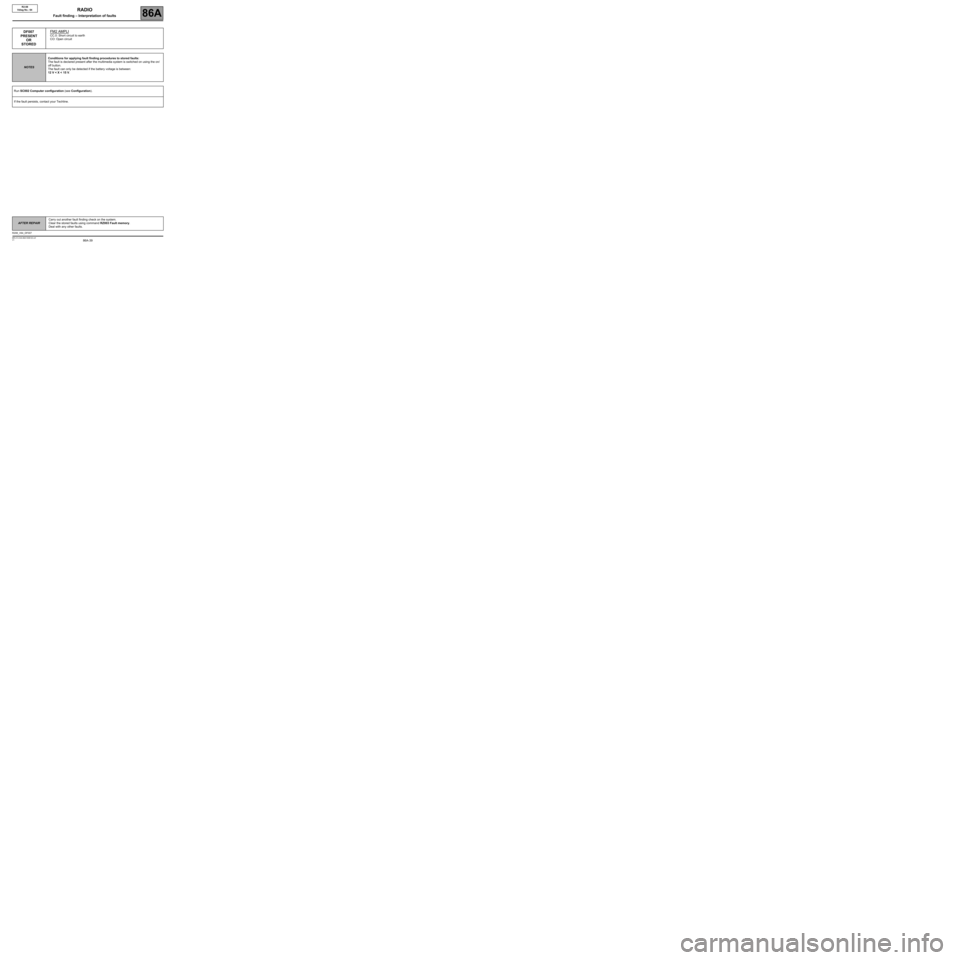
86A-39
AFTER REPAIRCarry out another fault finding check on the system.
Clear the stored faults using command RZ003 Fault memory.
Deal with any other faults.
V1 MR-413-X44-86A150$120.mif
RADIO
Fault finding – Interpretation of faults86A
R2-08
Vdiag No.: 64
DF007
PRESENT
OR
STOREDFM2 AMPLI
CC.0: Short circuit to earth
CO: Open circuit
NOTESConditions for applying fault finding procedures to stored faults:
The fault is declared present after the multimedia system is switched on using the on/
off button.
The fault can only be detected if the battery voltage is between:
12 V < X < 15 V.
Run SC002 Computer configuration (see Configuration).
If the fault persists, contact your Techline.
R208_V64_DF007